Three years ago, a team in Madrid scored 18 goals and conceded 6 from set pieces and beat Barcelona and Real Madrid to the Spanish La Liga title. While many small Premier League teams are famous for utilizing free-kicks, corners, and throw-ins, only Atlético Madrid have used set plays to win a title in a prestigious league. Diego Simeone’s team reached the final of the Champions League, too.
This season, however, set-piece ability has shifted from the Estadio Vicente Calderon to a stadium about 20 kilometres away, the Santiago Bernabeu, the home of Real Madrid. Zinedine Zidane’s Real has scored 19 and conceded only 4 goals from set-pieces. Atlético, on the other hand, have scored only 9 and conceded 7 from set pieces. Power has shifted from someone who was responsible for a sending off in a World Cup game to someone who was sent off in a World Cup game.
But why do we end up seeing lots of goals from this guy…

…and see Real Madrid on the brink of winning La Liga with primitive, cross-based tactics? And why is Barcelona, who has scored 13 more goals and conceded 8 less from open play, 3 points behind Real (after playing one extra game)?
Shot Quality
It’s not that Real Madrid have had a lot more free-kicks and corners than any other team this season. And Real haven’t really taken a huge amount of shots from set-pieces: only one more than Barcelona’s 80.
However, even with free-kick specialists Cristiano Ronaldo and Gareth Bale in their lineup, Real Madrid have stayed off using direct free-kicks, taking only 20 direct free-kicks. Barça, in contrast, have taken 45 direct free-kicks. Barcelona boasts many better free-kick specialists, but given direct free-kicks have only a 7-8% chance of going in, shooting directly from a free-kick isn’t a good strategy at all.
The fact that they chose to lob the ball into the box in a dead ball situation is not the only reason for Real Madrid’s success with set pieces. When they generate shots from set-pieces, they shoot from good locations. Here is Real’s shot map from free-kicks and corners:
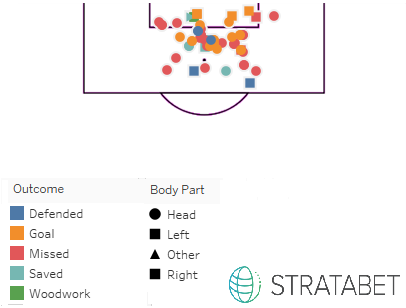
Almost all of Real’s shots come from the danger zone. Real Madrid produce a lot of shots from the six-yard box and just outside of it, which means they generate shots with very high xG. All this has led to Real Madrid converting 34.43% of their shots from indirect set-pieces, and 21.16% of all their shots from set-pieces. To add a little more context, here’s Barcelona’s shot map from set-pieces:
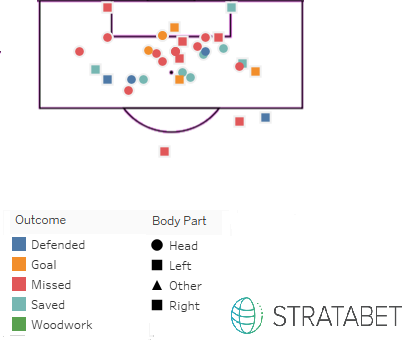
Clearly, there is a remarkable difference between Real Madrid and Barcelona’s shot selection. Barça take shots from far-out, wide locations. Only one shot came from the six-yard box, while three shots came from outside the box. Taking a shot from outside the box is a ridiculous thing to do with indirect set-pieces. Barça have converted only 17.14% of their indirect set piece shots and 12.5% of all their shots from dead ball situations.
Real Madrid’s brilliance while defending set-pieces should be attributed to shot quality as well. This is their shot map for set-piece shots conceded:
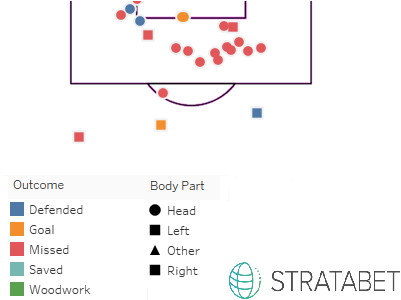
Real makes sure the shots they concede from set-pieces come from bad locations. The shots that have come from good locations (the red clump just outside the six-yard box) have not been converted, which is not sustainable. Barcelona, who have conceded 6 more goals from set-pieces than Real Madrid, are not all that bad, as their shot map for shots conceded from set pieces shows:
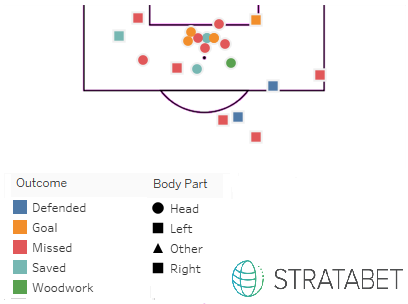
Neverthless, only 8.7% of Real Madrid’s shots from indirect set pieces turned into goals, compared to Barcelona’s 22.72%. For all shots conceded from set pieces, Barcelona’s conversion rate of 21.875% is a far cry from Real’s 7.14%. From this it looks like the key to Real’s excellent defence must be off-the-ball movement and marking.
Real Madrid are (very) good from set pieces because of shot quality. But how do they create good shots and concede bad ones? This is where data falls short. I looked at footage of Real Madrid’s set pieces to try to figure it out.
The Defence
Real Madrid prefer a hybrid marking system. They usually leave their explosive attacking triumvirate BBC guarding the six-yard area and the near post. BBC also stop outswinging corners before they curve into the middle. Four men will man-mark the attackers. Two or three players are left at the edge of the box, with one player trying to stop a short corner.

Another example of this was when they faced Napoli in the away leg in their round-of-16 Champions League tie.
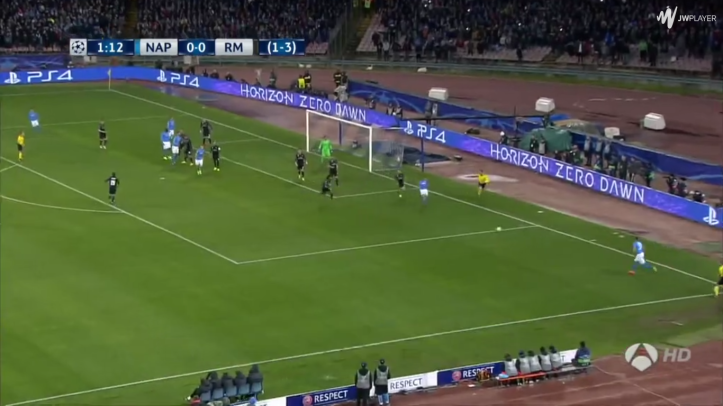
When Real Madrid have to defend a short corner, two of BBC (usually Bale and Cristiano Ronaldo) are left on the near post, with Benzema joining the man-marking area. One of the three who are generally posted at the edge of the box moves towards the wing, along with the other player whose job is to stop the short corner, to create a 2-versus-2 situation.
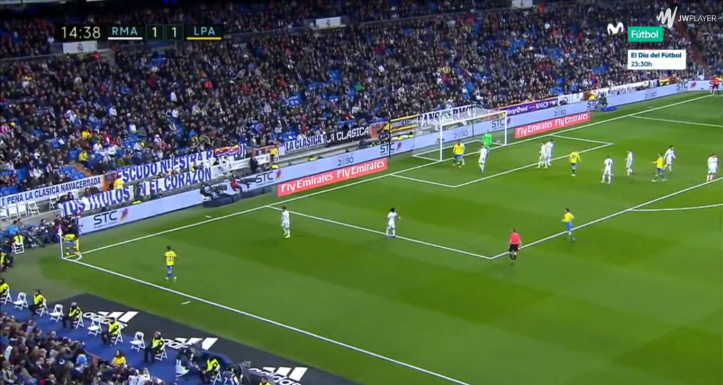
Against Napoli:
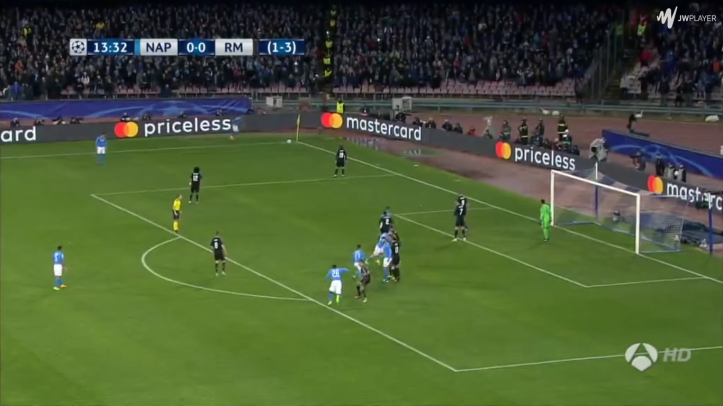
Real Madrid might have a bit of trouble when two or more attacking players go for the same header. This was the set-up for a free-kick from a tight angle when they faced Sevilla away from home:

When Pablo Sarabia executed an inswinger into the six-yard box, Sergio Ramos found himself competing with Wissam Ben Yedder and Steven N’Zonzi for a header. It was a familiar sight as Ramos scored another equalizer in the dying minutes. Only it was for his boyhood club Sevilla. Raphael Varane, who was close to those three, did not try to head out the cross.
In fact, it seems Varane might be the weak link while defending set pieces. Another example was the previous Clasico, when Real faced Barça at Camp Nou.
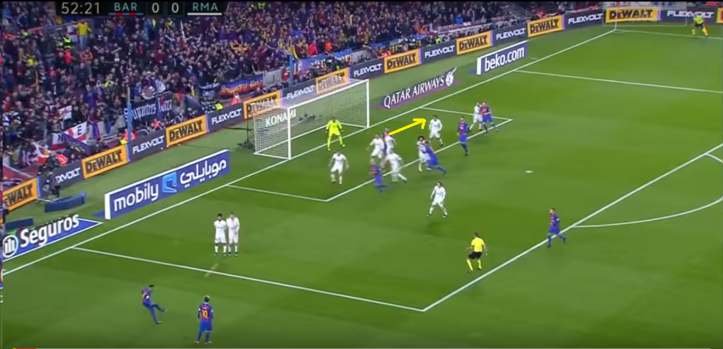
Real Madrid could have done one or two things differently. First of all, Real should not have committed two defenders for each attacker on the near post. The second thing is when Luis Suarez moved towards the ball, Varane ignored his movement and was caught on the wrong side of the Uruguayan striker. Suarez scored and put Barça one goal up, but it came to no use as a certain Spanish center-back we know very well equalized in the final minutes. But then again, it’s easier to notice one defensive mistake than many instances of good defending, so I may be wrong.
Teams find it almost impossible to put crosses into the most dangerous areas directly. If corners are delivered into the six-yard box, it can be caught or punched away by their Costa Rican goalkeeper Keylor Navas, who is quite an aggressive keeper for a club of Real Madrid’s level – he has claimed 2.64 crosses per 90 minutes and punched out 0.45 p90.
Attack
When Real Madrid win a corner or a free-kick in an advanced area, they send 5-6 players inside the box. One player stands in a deep position on the wings, poised to make a late run, and one or two players are kept outside the box.

But when Real Madrid players make runs into the six-yard box as soon as the ball is set in motion, Real Madrid are at their best. As you can see in the GIF below, three or more Real Madrid players move into the six-yard area, resulting in a great chance.
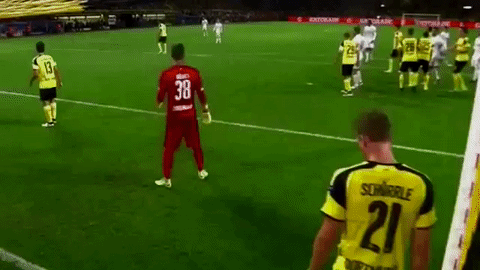
Another example is the following set-play, when Raphael Varane scored against Borussia Dortmund.

This goal also shows Cristiano Ronaldo’s skill (if that isn’t clear yet) in delivering an inswinging cross. He lobbed the ball at an unexpected moment and got it over the Dortmund wall (not the one at Signal Iduna Park) defending the six-yard box.
But this goal by Sergio Ramos is the most common routine from Real Madrid. Toni Kroos swung in the ball into the near post towards three tall Real Madrid players, namely Gareth Bale, Cristiano Ronaldo, and Sergio Ramos. One or two Real players typically move towards the far post, Pepe this time. Occasionally, Sergio Ramos makes this run, and it sometimes gets a goal for himself, or a goal for some other player, as defenders who know he is the preferred target swarm him. An example of this was when Casemiro scored against Athletic Bilbao.

Real Madrid doesn’t seem to have a weakness in set-plays. Stopping their attack requires a good defensive strategy, made after spending hours on the training ground.
Conclusion
If Real Madrid weren’t this good from set pieces, they wouldn’t be on the verge of winning La Liga since 2012. Some people have accused Zinedine Zidane of lacking tactical nous because Real Madrid play a cross-dependent, individualistic game. However, Zidane has made up for this by being very, very good at set pieces.
Now that I’ve made an attempt at analyzing Real’s set pieces, how can a team destroy them in dead ball situations? This article is getting way too long (good job for reaching this part, you have tremendous patience), so I’ll discuss this in another article which you can find here.
This article was written with the aid of StrataData, which is property of Stratagem Technologies. StrataData powers the StrataBet Sports Trading Platform, in addition to StrataBet Premium Recommendations.

[…] my article posted the day before yesterday, I discussed why Real Madrid are excellent from set pieces. But can the set-up be broken with a few […]
LikeLike
[…] my article posted the day before yesterday, I discussed why Real Madrid are excellent from set pieces. But can the set-up be broken with a few […]
LikeLike